Meghalaya is an Indian state located in the northeastern part of the country. This state’s lovely landscapes and mountains cover most parts of the region. There are also several ancient caves along with enchanting waterfalls that contribute to the beauty of the state. The state consists of many ethnic groups that live in Meghalaya with their respective religious and cultural beliefs. Let us tell you about the festivals of Meghalaya, which you should experience in person.
Meghalaya
1) Nongkrem Festival
This festival holds significance for the Khasi group. The head of the Khasi state, Syiem, and Ka Syiem Sad does the rituals as the Khasi group considers them to be the caretaker of the ceremonies and the people. People believe that the Nongkrem Festival can bring people a good harvest, prosperity, and peace. The young women do the Shad Kynthei, and the men will circle while performing the Shad Mystieh. It is regarded as the symbol of male power and protection for their women. People worldwide visit this place to partake in the Nongkrem Festival in Meghalaya.
During the celebration, the young virgin girls of Khasi will wear expensive silk and gold ornaments and dance at the Ka Shad Kynthei in the inner part of the arena. In contrast, the males of the Khasi clan wear dhoti, sleeveless coats, full-sleeved shirts, and a turban in the outer circle. This dance shows the male power and their dedication to providing their women with protection.
Key Attraction: Delicious Khasi Food, traditional dresses, and Shad Mystieh dance.
Place: Smit
When: This festival is celebrated during the Autumn Season (November)

2) Shad Sukra
Jaintia people of Meghalaya celebrate this festival every year before the sowing season. After the festival, the sowing of seeds takes place. The dance, rituals, and music to receive good harvests and fruitful crops. Both males and females participate in this festival and wear traditional outfits, and the people will wear heavy gold jewelry.
Key Attraction: rituals and dance accompanied by the flutes and drums.
Place: You can experience this festival in Jowai Town, West Jaintia Hills
When: The celebration takes place in April/May
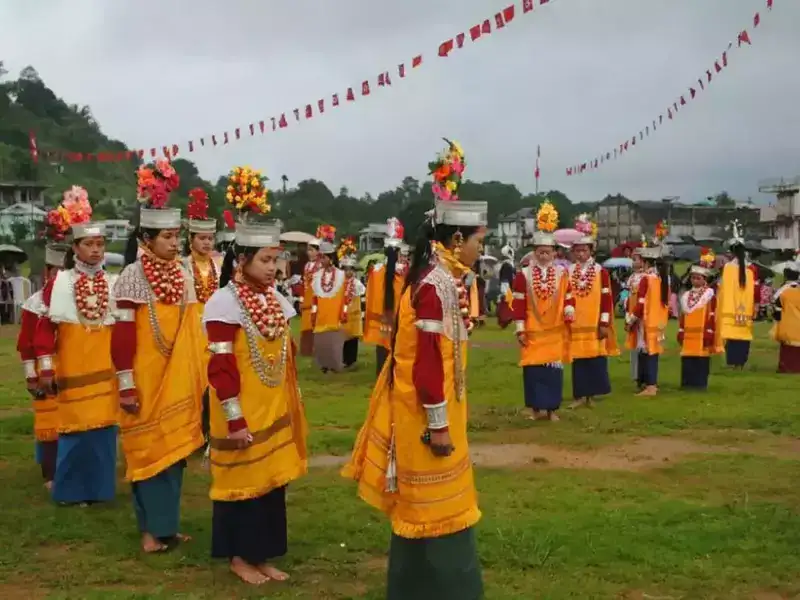
3) Shad Suk Mynsiem
The individual family clans or the Khasi state perform the ceremonies. They perform the rituals. A dance performance will signify the patrilineal and matrilineal structure of the Khasi clan. The single girls will be dressed in their traditional clothing while dancing. The men will circle the women in their lashing whips and swords. This form of dancing helps to signify that men are the protector of their women and honor them as their wives.
The Khasi people love and adore nature, which is why they celebrate to show gratitude towards mother earth for better harvesting and seed sowing. The dance from the festival shows in which women dance with soft steps whereas men dance more energetically. Several musical instruments are played, such as drums, bells, and cymbals.
Experience: The bright and colorful dance performance.
Place: the festival takes place on the Wiking Grounds
When: The festival is celebrated in April.
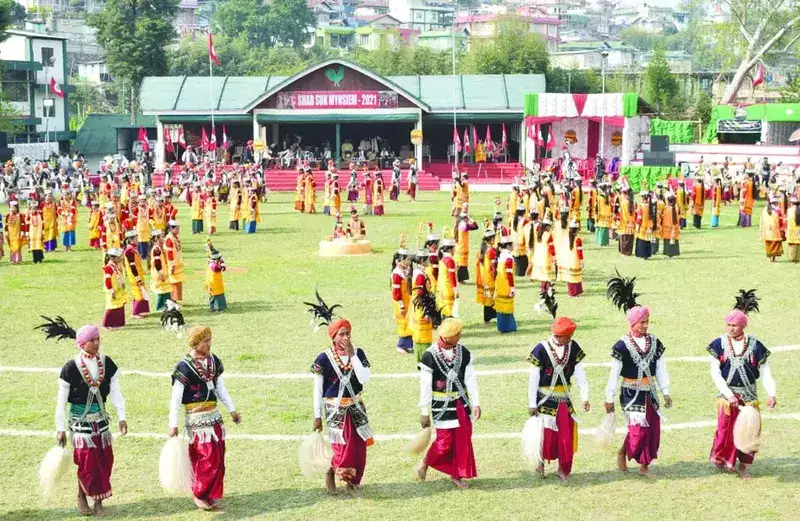
4) Behdienkhlam Festival
The Jaintia people of the Niamtre religion celebrate this festival. The festival goes on for three days. Behdeinkhlam Festival is amongst the most important festivals celebrated before the seed sowing season. All of the rituals and ceremonies are performed by the priest. The festivals also consist of the beating of drums and flute. Men will be playing the flute and drums, and women will watch their men perform dressed in traditional attire with gold jewelry.
There will also be a tree trunk wrestling which will be chosen carefully during the main event. It is considered that this festival will bring good luck to whoever touches it. This festival attracts many audiences and tourists due to the colorful bright events.
Key Attraction: Many bamboo structures are decorated with colored paper and tinsel.
Place: This festival takes place in the Villages Of Jaintia Hills and Jowai Town
When: The month of July is the time of this festival.
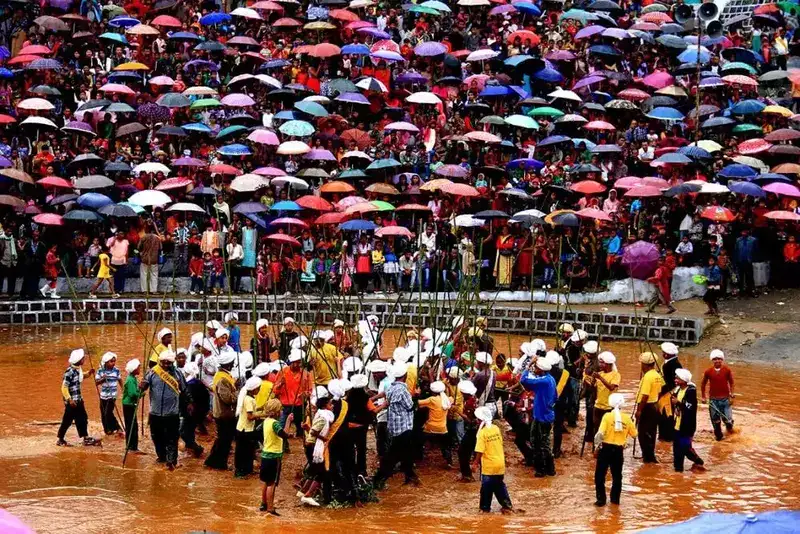
5) Strawberry Festival
The Meghalaya state celebrates this festival to enhance and promote fruit farming. This state is the best location for the cultivation of strawberries, which is the primary reason why the government of Meghalaya encourages its farmers to promote the production of strawberries. This festival is not only for the families to enjoy and be part of it, but it also contributes to the growth of local farmers and supports the state’s economy.
When: February
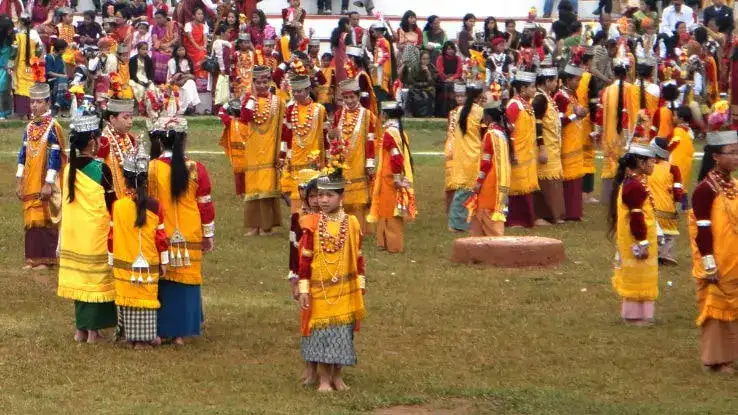
6) Wangala Festival
Garo people consider the Wangala festival to be the most important. The post-harvest festival is celebrated to celebrate the end of the agricultural year. Wangala festival is the thanksgiving festival of the god of fertility, the Misi-A-Gilpa-Saljong-Galapa. This festival today is also known as the Hundred Drums festival.
Accompanied by the cries of the leading warrior, the god will lead both men and women to synchronize the dance steps with hand and head gesturing movements. During the festival, Nagara will be beaten, for which women and men will gracefully dance. The dress code for the festival is Dhotis, turbans, and half-coats with feathers, and women will wear colorful dresses made of silk and blouses along with a head wrap with feathers. The females also use feathers to wrap their heads and wear colorful dresses that look beautiful.
During the celebration of this holy festival, special drums are played along with people dancing full of energy.
Key Attraction: Hundreds of men playing drums.
When: The festival is celebrated from September to December.
Place: to those who want to witness the authentic way of celebration by the Garo people, you can find them in the Songsarek villages, such as the Sadolpara in West Garo Hills.
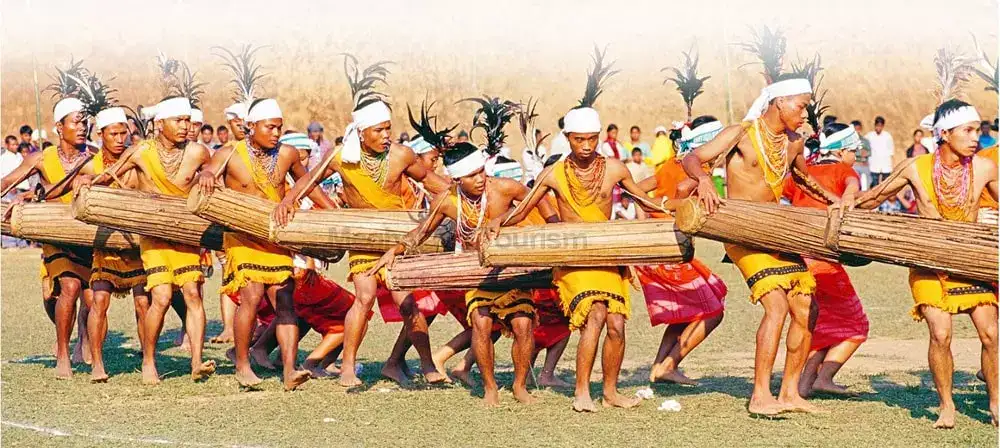
7) Seng Kut Snem
This festival celebrates the faith and culture of the Khasi clan and marks the prominence of the Seng Khasi movement. In 1899, 16 young men formed a group known as the Khasi Young Men associated with preserving the indigenous method of life under the assault by the Brits. Hence, the Seng kut Snem was the initial celebrated festival to mark the anniversary of the Khasi Young Men organization. Later, in 1901, the organization was renamed Seng Khasi, and now the festival is celebrated yearly to commemorate the movement. This occasion is the community prayer which believes will protect the distinct identity of the Khasi clan. Unlike new year’s eve, elders impart the teachings and hold programs for the traditional beliefs, faith, etiquette, and customs of the Khas clan during the celebration.
Key Attractions: Countless people show up in their finest traditional clothing to celebrate the festival.
When: November
Where: Shillong
Duration: One Day











